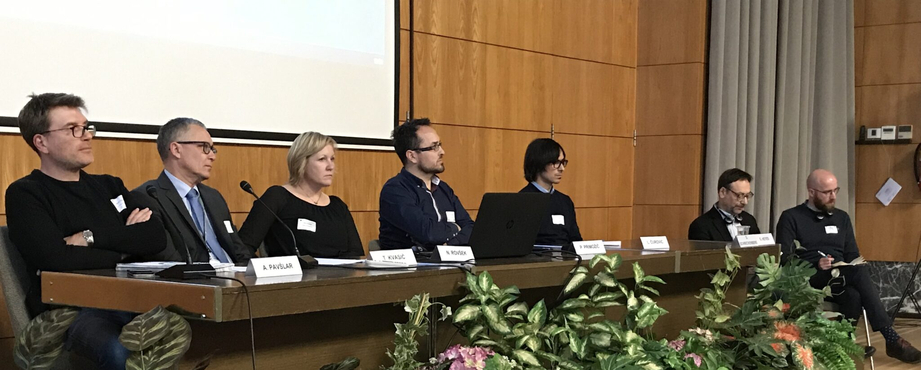Success strategies for noise mitigation in airport areas: Communication and two-way dialogue with communities
December 18, 2019
Noise management in airport areas can only be successful with the presence and dialogue between parties that are involved in creating the noise, but also those who can hear it.
The ANIMA community engagement event, organised in Kranj, Slovenia aimed to put all relevant parties in the same room and see how they can improve and develop the transparency and efficiency of their communication. The event saw the presence of the airport sector (Fraport Slovenija), Air Navigation Service Providers (Slovenia Control), the Civil Aviation Agency, institutional bodies (Ministry of Infrastructure, Ministry of Environment and Spatial Planning, Institute of Occupational Safety, National Institute of Public Health), and the local communities (City Municipality of Kranj and residents’ representatives).
Kranj: Local authorities don’t often know what the airport is doing
Kranj is the third largest city in Slovenia and is only 10 kilometres away from Ljubljana Airport, hence aircraft noise has an impact on those who live under flight paths.
While collaborative decision-making groups for the development of common noise policies already existed, the local authorities and communities were often left out from the discussions, and decisions have been taken without informing them.
For example, in 2013 there was a unilateral change of routes, where the local authority was neither informed nor consulted, explainedMarko Čehovin, from the City Municipality of Kranj. Local communities need to be part of the decision-making process, because we are directly affected, he added. The situation is improving, as Andreja Kikec Trajković, from the Civil Aviation Authority (CAA), explained that the CAA adopted a new regulation to avoid any implementation of flight procedures without environmental assessment and public consultation.
Not looking for the perfect solution, but for consensus
This event was an opportunity for the decision-making groups around Ljubljana airport to resume activities, but also to incorporate more actors than before.
Janez Černe, the deputy mayor of Kranj, welcomed the initiative of the ANIMA project: To organise such workshops with the communities is necessary to allow citizens to be heard. We want equal quality of life as the rest of Slovenians and the disturbances need to be studied and analysed.
The operational stakeholders (airports, Air Navigation Service Providers, etc.) and the regulators need to take a proactive approach to community engagement and noise mitigation. The ANIMA project coordinator, Laurent Leylekian, insisted that communication must be inclusive and transparent. There is a need to enlarge the scope of the dialogue from just mere technical data to human dialogue, not necessarily seeking a perfect solution, but consensus. If a fair, inclusive and transparent decision-making process is set up with all stakeholders including neighbouring communities, then authorities and airports must be ready to accept and endorse consensus reached through the process, a point which is challenging too.
Community engagement must be meaningful, consistent and comprehensive
Airport-community engagement is too often a one-way process. Fair and two-way dialogues are essential, allowing communities to express their opinion and to be considered in decision-making. Graeme Heyes, from Manchester Metropolitan University, highlighted that we need to expand the focus of noise management beyond noise exposure reduction, and address impact directly by increasing competence and fairness between airports managers and communities.
Sharon Mahony, from EUROCONTROL, presented the Collaborative Environmental Management (CEM) specification, a tool which could help address noise management, while including local communities in the process as well. CEM is a process that brings together stakeholders at airports to identify environmental impacts and to enable a coordinated response that minimises them.
Primož Primožič, from Fraport Slovenija, added that to counter some of the environmental impacts of the airport activities, Fraport Slovenija decided to create a Collaborative Decision-Making group which involves the most important stakeholders at airport level. In the second stage of this group, local authorities and communities will be involved. The goal is to develop common noise policy for impact mitigation.
The main takeaway of this ANIMA event is that when it comes down to noise management, prevention and proactivity are key. If legislation is not yet available at the degree of needed protection, initiatives to increase quality of life must still be taken at national, regional and municipal level. Often times, the level of awareness is not the same among stakeholders, hence the importance of working collaboratively towards common noise policy which benefits all parties. Better awareness and knowledge on different noise sources and indicators would support the understanding of impact that noise has on human health and well-being in different.
This event has restarted a much-needed dialogue around Ljubljana airport, and the ANIMA project expects to continue this trend in other locations. ANIMA coordinator considers that the resumption of talks is timely as the aviation noise issue is not critical now in Kranj, further to the activities’ stoppage of the main national airliner.
Coming up
The ANIMA project will be present at the Aerospace Europe Conference (AEC2020), an event which will feature 3AF 3rd Greener Aviation, CEAS 7th Air & Space Conference and the 8th edition of Aircraft Noise and Emissions Reduction Symposium (ANERS). The project will have a stand at the exhibition for the promotion of results and for enhancing user engagement, while a number of project partners will disseminate their research in the conference.
You can access the presentations and the report of the event below.

